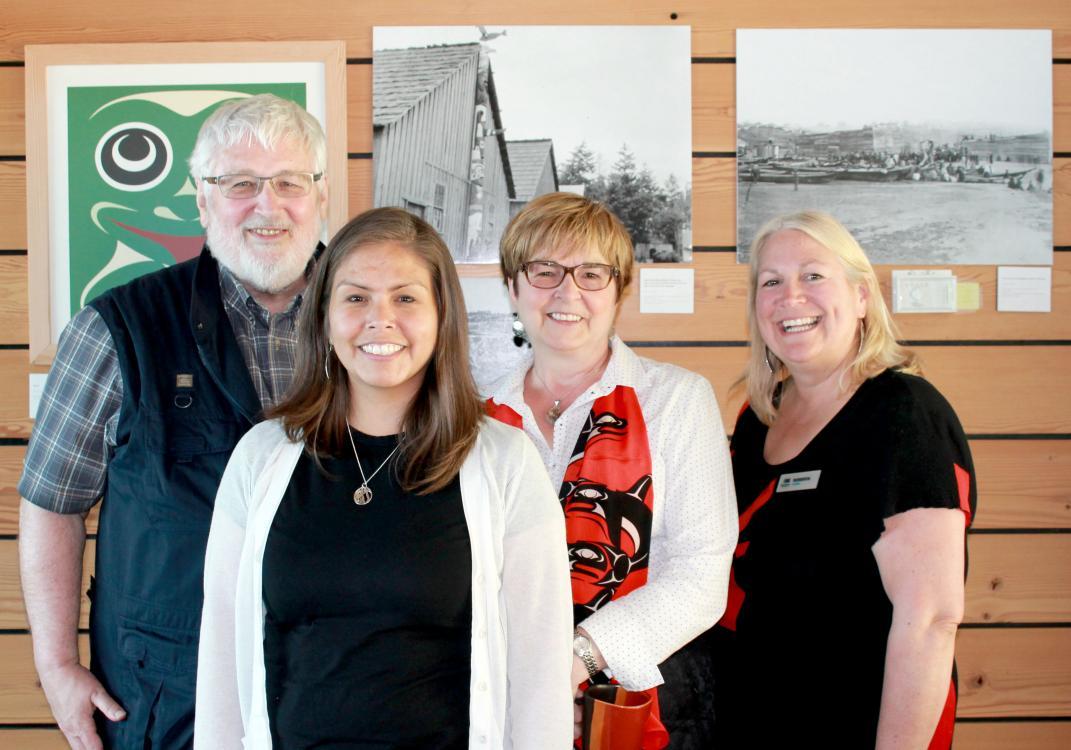Weaving our cultural fabric: the 100-mile art collection
Share online

George and Christiane Smyth just wanted to fill the bare walls of their new condo when they moved to Victoria in 2003. But what began as an interior decorating decision – buying some prints from local First Nations artists – has burgeoned into an important collection of contemporary Coast Salish art. As their interest grew, they ran out of wall space at home, and now focus on donating pieces to educational institutions.
Royal Roads University celebrated the Smyths’ donation of 18 prints from their Salish Weave Collection at a special ceremony June 19 at Sneq’wa e’lun (Blue Heron House). Speakers included Beecher Bay Elder Burt Charles and T’Souke Elder Linda Bristol, both members of the Royal Roads Elders Circle. As thanks for the gift, Indigenous Education and Student Services Manager Asma-na-hi Antoine gave the Smyths each an eagle feather, symbols of protection, guidance and spirituality.
“We were overwhelmed with gratitude at the generosity of the donation,” said Antoine, who, with the help of the Royal Roads archivist, sourced historical photos depicting Coast Salish families from Esquimalt, Songhees, Saanich, Beecher Bay, T’souke and Cowichan, to display next to the artworks. “The impact of the display is just amazing, allowing us to be inspired and more informed about the history of the land.”
The 18 prints include works by Coast Salish artists Susan Point, LessLIE, Chris Paul, Andy Everson, Maynard Johnny Jr., Dylan Thomas, Luke Marston and John Marston. Royal Roads employee Mike Bell crafted the frames using wood left over from the Blue Heron House building project. The repurposed wood was donated by Vancity from a hangar deconstruction in Comox.
“The art work, combined with the archival photos, becomes an instant point of discussion and connection for those who visit this beautiful building,” says Vice-President, Communications and Advancement Katharine Harrold. “The Smyth’s vision of education through the sharing of art is being realized here and is actively benefitting students and staff alike.”
The Coast Salish style is a unique blend of three design elements – crescents, circles and trigons (curved triangles). Coast Salish territory encompasses the east coast of Vancouver Island, and some parts of the Lower Mainland, Washington and Oregon.
The Smyths, both retired from careers in technology research in Ottawa, have amassed about 300 art pieces and more than 2,000 prints including 27 commissions, collectively known as the Salish Weave Collection. In addition to Royal Roads, the Smyths have donated parts of their collection to Vancouver Island University, University of British Columbia and the University of Victoria. The Smyths’ Salish prints also hang in Government House in Victoria, Canada House in London and the National Gallery in Ottawa. When a Musqueam First Nation delegation visited New Zealand, they brought donated prints from the Smyth’s collection. “We want to find good homes for what we call ‘the kids,’” said George.
Despite all their generosity, the Smyths don’t consider themselves philanthropists. “We didn’t see many private collections of Coast Salish art. Our objectives were to support education through the indigenous art. “said George.
Added Christiane, “That’s our reward, seeing what institutions like Royal Roads do with the art and how they activate it.”
For more information on the collection, go to http://www.salishweave.com/
Photo: L-R: Donor George Smyth, Indigenous Education and Student Services Manager Asma-na-hi Antoine, donor Christiane Smyth, Associate Vice-President Student & Academic Services Roberta Mason.